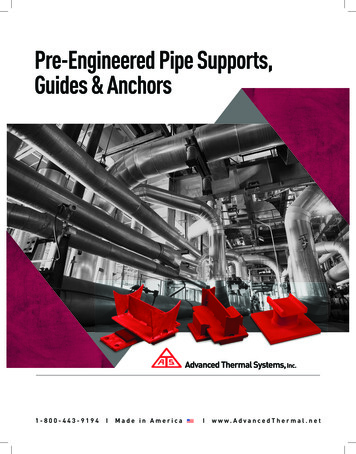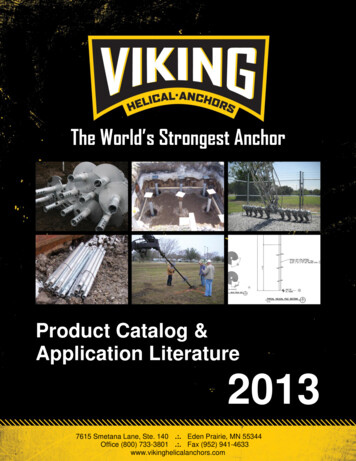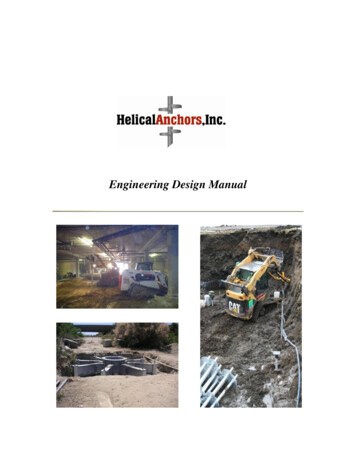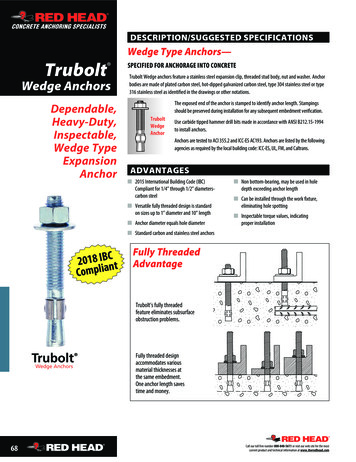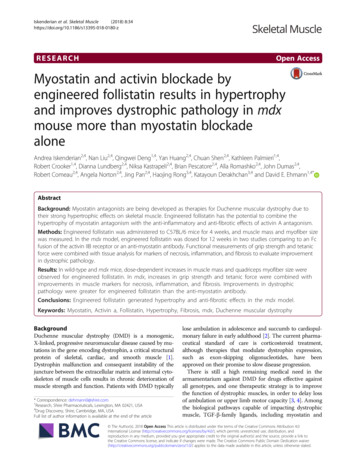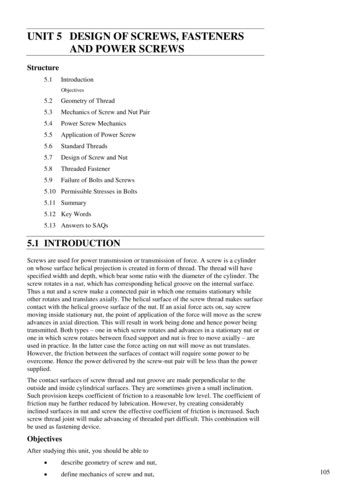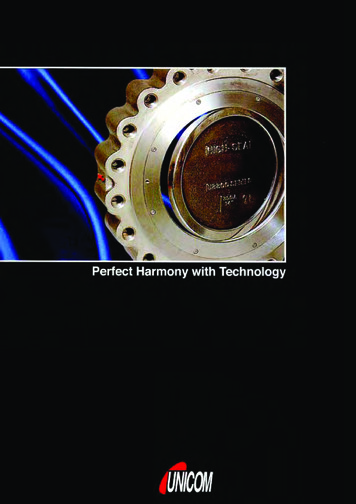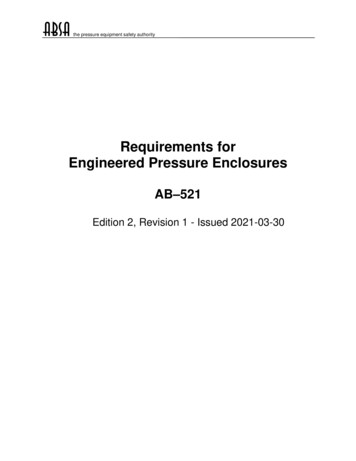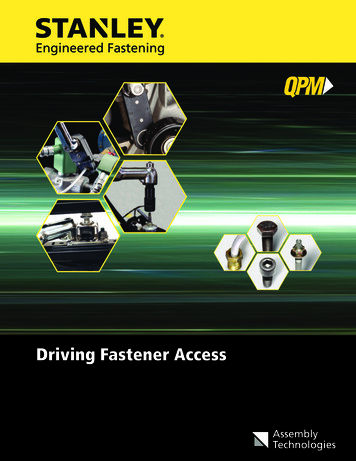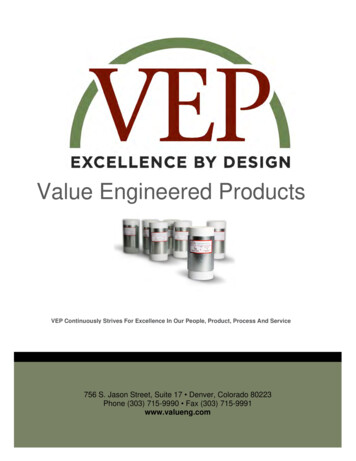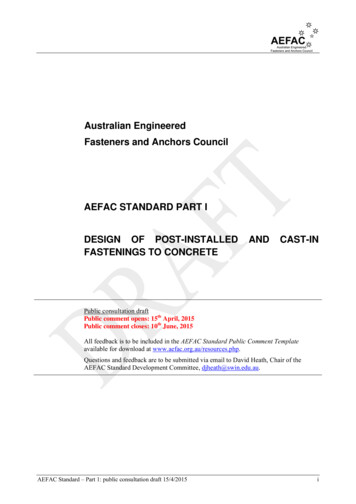
Transcription
Australian EngineeredFasteners and Anchors CouncilAEFAC STANDARD PART IDESIGN OF POST-INSTALLEDFASTENINGS TO CONCRETEANDCAST-INPublic consultation draftPublic comment opens: 15th April, 2015Public comment closes: 10th June, 2015All feedback is to be included in the AEFAC Standard Public Comment Templateavailable for download at www.aefac.org.au/resources.php.Questions and feedback are to be submitted via email to David Heath, Chair of theAEFAC Standard Development Committee, djheath@swin.edu.au.AEFAC Standard – Part 1: public consultation draft 15/4/2015i
PREFACEThis Australian Engineered Fasteners and Anchors Council (AEFAC) Standard Part 1 was prepared by theAEFAC Standard Development Committee. This document was approved on XX/XX/2015.This Design Guideline was published on XX/XX/2015 and is available at www.aefac.org.au.The following are represented on the AEFAC Standard Development Committee: Allthread Industries Pty LtdAncon Building ProductsAustralian Building Codes BoardAustralian Engineered Fasteners and Anchors CouncilAustralian Steel InstituteAustralian Window AssociationCommonwealth Scientific and Industrial Research Organisation (CSIRO)Concrete Institute of AustraliaEdith Cowan UniversityEngineers AustraliaHilti (Aust.)Housing Industry Association LtdHobson Engineering Company Pty LtdITW Construction SystemsNational Precast Concrete Association AustraliaSimpson Strong-TieStanley Black & Decker Australia Pty Ltd (Powers)Swinburne University of TechnologyWürth Australia Pty LtdThis Standard has adopted the terms ‘normative’ and ‘informative’ for the appendix to which they apply.A ‘normative’ appendix is an integral part of the Standard, whereas an ‘informative’ appendix is providedfor information and guidance.AEFAC Standard – Part 1: public consultation draft 15/4/2015ii
CONTENTSPreface . ii1234Scope and General . 11.1Scope and application . 11.2References . 21.3Definitions . 21.4Notation . 8Materials and installation . 172.1General . 172.2Types of fasteners and fastening groups. 172.3Dimensions of fasteners . 172.4Fastener materials . 182.5Concrete. 182.6Reinforcement . 182.7Installation . 18General design requirements . 193.1General . 193.2Verifications for design . 193.3Concrete condition. 203.4Report of Assessment . 213.5Verification of fastener strength . 21Determination of forces acting on fasteners . 304.1General . 304.2Headed fasteners and post-installed fasteners . 304.3Anchor channel . 354.4Supplementary reinforcement. 365Detailing of supplementary reinforcement . 386Design for tensile loading . 4076.1General . 406.2Post-installed fasteners and Cast-in headed fasteners . 406.3Cast-in anchor channel . 53Design for shear loading . 607.1General . 607.2Post-installed fasteners and Cast-in headed fasteners . 60AEFAC Standard – Part 1: public consultation draft 15/4/2015iii
7.38Cast-in anchor channel . 68Design for combined tension and shear loading . 738.1Steel failure. 738.2Failure modes other than steel . 748.3Additional verification for fasteners with supplementary reinforcement . 759Design for serviceability. 779.1Verifications . 779.2Displacement . 779.3Limiting crack width . 7710Design for fatigue loading . 7810.1General . 7810.2Strength of fastener. 7811References . 82Appendix A (informative) Assumptions for the design and execution of fasteners . 84A.1 General . 84A.2 Post-installed fasteners . 84A.3 Cast-in headed fasteners . 84A.4 Anchor channel . 85Appendix B (informative) method of design for post-installed fasteners . 86B.1 General . 86B.2 Design method A . 86B.3 Design method B . 87B.4 Design method C . 88Appendix C (normative) Verification of resistance of concrete elements to loads applied by fasteners . 89C.1 General . 89C.2 Lightly loaded applications . 89AEFAC Standard – Part 1: public consultation draft 15/4/2015iv
11.1SCOPE AND GENERALSCOPE AND APPLICATION1.1.1ScopeThis Standard provides the minimum requirements for the design of individual fasteners or fastener groupsused to transmit loads to concrete.The type of fasteners covered in this Standard are as follows –a) Post-installed fasteners –(i) Mechanical anchors (e.g. expansion anchors, undercut anchors and concrete screws)(ii) Chemical anchors (e.g. bonded anchors, bonded expansion anchors)b) Cast-in fasteners –(i) Headed fasteners(ii) Anchor channel with rigid connection (e.g. forged or welded) between the channel andanchor1.1.2ApplicationThis Standard is intended to apply to the design of safety-critical fasteners to concrete structures.The design theory for fasteners embodied in this Standard utilises the tensile strength of concrete and isclosely based on the design procedure published in prEN 1992-4 “Eurocode 2: Design of concretestructures – part 4: design of fastenings for use in concrete”.This Standard relies upon design parameters and product specifications that are stated in the correspondingReport of Assessment (refer to AEFAC Standard Part 2).Concrete members shall be composed of normal-weight concrete without fibres with further provisionsprovided in Clause 2.5.Supplementary reinforcement and reinforcing steel inserts in bonded anchors shall have a ductility classtype N in accordance with AS/NZS 4671.1.1.3ExclusionsThis Standard is applicable to the design of permanent structures. It is not intended for the design offasteners for use in applications pertaining to lifting, transport or erection of prefabricated concreteelements.This Standard shall not be used for the design of fasteners that do not have a Report of Assessment.This Standard does not apply to fasteners in redundant non-structural systems whereby excessive slip offailure of a fastener will result in the load being transmitted to neighbouring fasteners without violating theserviceability and ultimate limit state requirements of the fixture.This Standard does not apply to other types of fasteners such as lifting inserts, brace inserts, ferrules, postinstalled reinforcing bars, headed reinforcement or anchorage for prestressing strands.The design provisions in this Standard for anchor channels do not apply to the following –AEFAC Standard – Part 1: public consultation draft 15/4/20151
i) Shear in the longitudinal direction of anchor channel.ii) Fatigue loadingThis Standard does not cover the design of fixtures.1.1.4Loading on fastenersThe design provisions in this Standard are relevant to static, quasi-static and fatigue loading and mayinclude tension, shear, bending or torsion moments, or a combination thereof.A fastener shall have a nominal prequalification for static loading and shall receive explicitprequalification for fatigue loading as noted in the Report of Assessment in order to be eligible for use infatigue applications.The mechanism for transfer of axial compression shall be either direct bearing of the bottom plate of thefixing on the concrete, or via fasteners specifically suitable for the transfer of compression.1.1.4.1Exposure to fireThis Standard does not address the design of fasteners for exposure to fire. The fasteners shall bedesigned for exposure to fire in accordance with fire engineering principles.1.1.4.2DurabilityThis Standard does not cover design for durability.Note: It is assumed that the fastener possesses the necessary durability performance throughout itsintended service life without the need for undue maintenance.1.1.4.3Seismic designThis Standard does
ccr,V edge distance of a single fastener required to ensure the characteristic strength of the fastener is achieved when loaded in shear. cmax maximum edge distance to the fastener. cmin minimum edge distance to the fastener. c1 edge distance in direction 1. c2 edge distance in direction 2.
